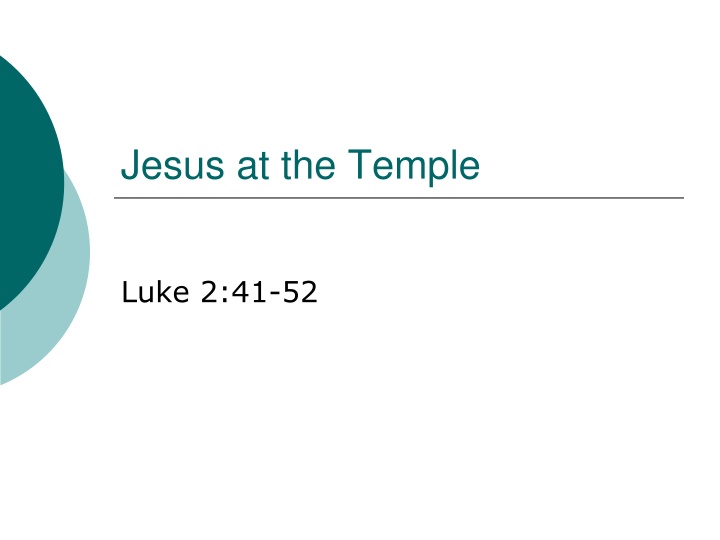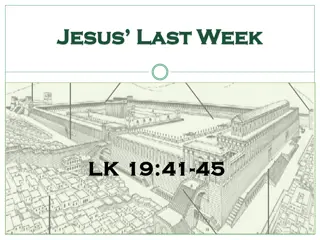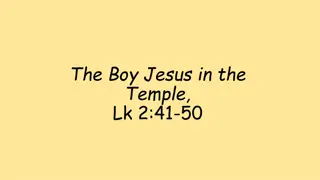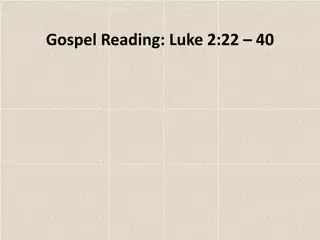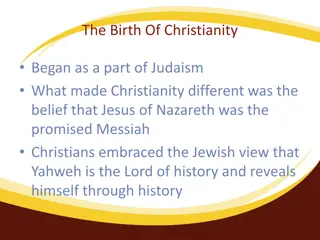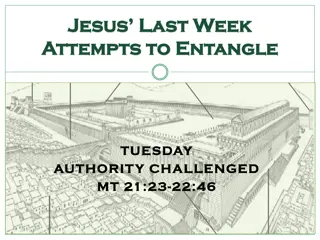Jesus at the Temple
Narrative of child Jesus at the Temple in Luke 2:41-52. Discover the genre of the passage, how it conveys meaning, and key terminology used in the text related to Jerusalem, the Temple, and Passover.
Download Presentation

Please find below an Image/Link to download the presentation.
The content on the website is provided AS IS for your information and personal use only. It may not be sold, licensed, or shared on other websites without obtaining consent from the author.If you encounter any issues during the download, it is possible that the publisher has removed the file from their server.
You are allowed to download the files provided on this website for personal or commercial use, subject to the condition that they are used lawfully. All files are the property of their respective owners.
The content on the website is provided AS IS for your information and personal use only. It may not be sold, licensed, or shared on other websites without obtaining consent from the author.
E N D
Presentation Transcript
Jesus at the Temple Luke 2:41-52
Where do we find this passage? The story of the child Jesus at the Temple is found in chapter 2 of the Gospel of Luke. No other author in the Second Testament has this story, which means it must have come from an oral source known only to Luke.
What is the genre of this passage? This passage is written as a recount it tells of something Jesus did. However, it has been written in the style of a narrative, so it follows a narrative structure and has lots of features common in narratives A clear plot Defined characters Lots of action (verbs) and detail Dialogue A climax
How does this literary form convey meaning? This story contains different sorts of truths. Because it is a narrative set in a real time and place it has some literal truths. (eg Jerusalem, The Temple, the Passover.) Because this is a narrative it tells other truths about attitudes and values, about life, about relationships, about people and about God. Because it was written to persuade people to know Jesus as God in human form, it contains truths of our faith truths about Jesus.
Terminology used in this text Jerusalem The capital of Palestine. The Temple, heart of religious practice, was located in Jerusalem. Three times a year Jews were obliged to come to the Temple for religious festivals.
Terminology used in this text Passover One of the three festivals which required the Jews to journey to the Temple in Jerusalem. The feast remembered the exodus from Egypt, in particular the passing over of the angel of death on the Hebrews houses (Ex 12:13)
Terminology used in this text The family or a group of men would choose the sacrificial lamb and bring it to the Temple to be slaughtered. It had to be a perfect lamb, with no blemishes. The priest would slaughter the lamb and give the people bitter herbs and unleavened bread to eat. After evening prayers, meat would be taken from the cooked lamb. The people would be ready: loins girded, sandals on, staves in hand. They would eat in haste and anything found next morning would be burned.
Terminology used in this text There are some interesting phrases and words in this passage. 12 years old In Jewish law a child was ready to take responsibility for the observance of their faith between ten and thirteen. the boy Jesus stayed in Jerusalem Jesus was not left behind by careless parent he chose to stay in Jerusalem. The words imply a deliberate action on the part of Jesus. relatives and acquaintances Those travelling to Jerusalem from the same village would have travelled together as a party or caravan. As a result, Jesus relatives and friends would have been with Mary and Joseph it was therefore quite likely that the young man was with his friends.
Terminology used in this text 3 days later At a literal level, the number indicates that Jesus was missing for some time. Symbolically, the number makes us think of the resurrection, when Jesus will again be lost for 3 days. my father s affairs This passage may translated in different ways. Some Bible s say my father s house , others say my father s things . The best translation makes it clear that Jesus is not just passively visiting God s house, he is actually doingGod s work. Jesus is engaged in an activity he is doing what he does best answering questions.
